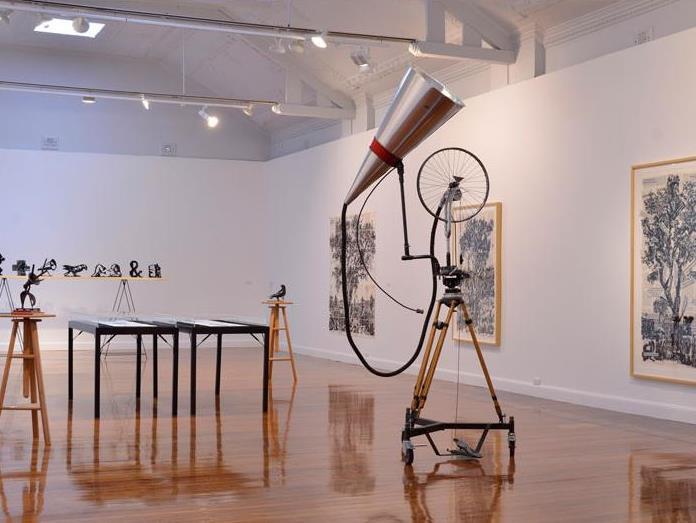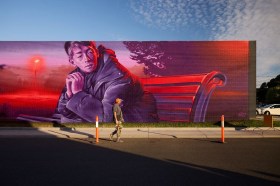Installation view of Kentridge’s eighth solo exhibition at Annandale Galleries, SO; copyright William Kentridge; Photo courtesy Annandale Galleries
This is the kind of exhibition you would expect to see in the art gulches of New York City, London or Paris rather than the back streets of the Sydney suburb Annandale. To have an exhibition of this calibre – and scale – by the internationally celebrated William Kentridge could easily be described as a coup by Annandale Galleries, especially given the number of red dots on these phenomenally priced works, several of which are going to important collections.
What we have to remember is that this is the eighth solo exhibition tracking a relationship over some 19 years since Kentridge’s first show with Annandale Galleries in 1995. The title, then, of this exhibition, So, is not a ‘so there!’ with the arrogance of conquest but rather ‘and so’, a sincere and continuing journey, like the next page turned.
It is an apt metaphor for this exhibition, which is largely centred around the turning of pages – mainly those of the Shorter Oxford English Dictionary – across iconic Kentridge animations and as framed sequential ink drawings and linocuts.
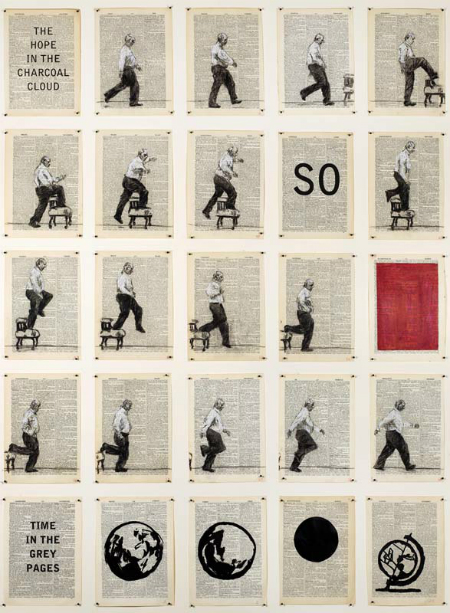
The Hope in the Charcoal Cloud / Time in the Grey Pages (2014), copyright William Kentridge; Photo courtesy Annandale Galleries
Like most of Kentridge’s work, there is a lot going on in these pieces veiled by their simplicity. A narrative builds, is deconstructed, and then weaves itself again across various mediums, so that the viewer moves through the exhibition with familiarity, which in turn draws you in deeper through that level of comfort to then ask questions, from the most elementary wonder in Kentridge’s technique to the societal and political underpinnings of these works.
Rarely do we see an exhibition approached with such erudite cohesion; an ink drawing on a page becomes a projected animation, a metal sculpture, or the literal object is presented as an assembled on a timber tripod. The more time you spend with the work, you find yourself visual and emotional bouncing between pieces and ideas, like a seductive waltz.
Typically there is Kentridge’s signature stamp of theatricality and orchestration. He is a masterful director, and as Gallery Director Bill Gregory has described, the overall arching theme is one of transformation.
A stunning example of this is a suite of Rebus bronze sculptures from 2013 that, when viewed from different angles, morph into something entirely unrelated, where the linear description of a bird becomes a cage, for example, or a walking man turns into a tree, and an ampersand into a man’s head. A kind of alchemy is performed before one.
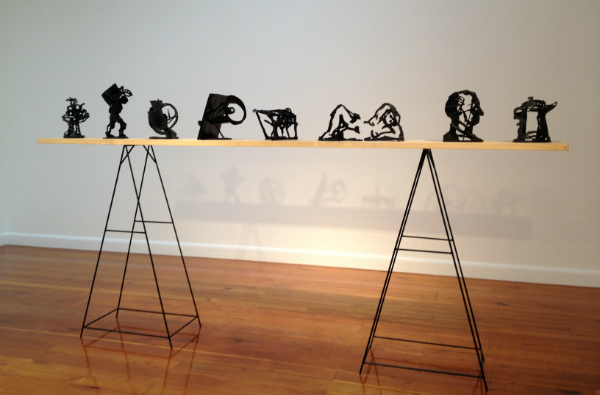
Installation view at Annandale Galleries of Rebus (2013) suite of 9 bronzes; copyright William Kentridge; Photo courtesy Annandale Galleries
Presented almost at eye level, on a trestle superbly constructed in its simplicity, the complexity is again honed to simple eloquence. Several other assemblages around the gallery take narrative into another dimension.
The walls of the main gallery shows a combination of large multi-panel linocuts and ink drawings of mind-boggling technical precision. Of particular note is the 63-panel piece Remembering the Treason Trial (2013), which refers to Nelson Mandela’s trial of the 1950s. While it speaks of a specific moment in history and geography its message is universal and timeless; Kentridge’s red pencil marks notations of registration, framing and placement work as a reminder of keeping things in place. And, yet, fragments of text that pepper this organic and lush specimen of a tree evoke hope and growing futures.
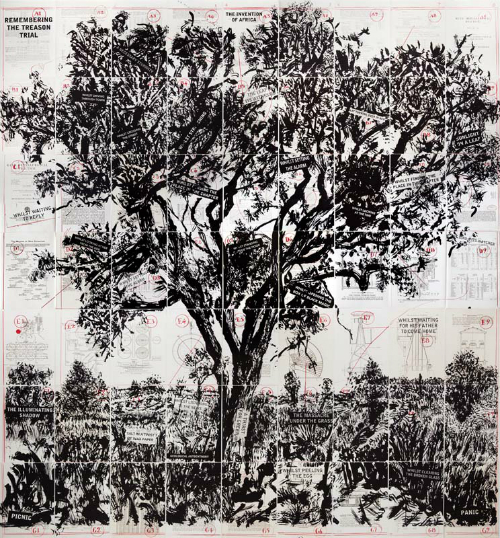
Remembering the Treason Trial (2013); 63 panels hand printed on a Takach litho press in 3 runs; copyright William Kentridge; Photo courtesy Annandale Galleries
Central to this exhibition – and the point to which every work returns – is a large projection Second Hand Reading (2013), a flipbook of drawings on single pages from the Shorter Oxford English Dictionary set to a stunning soundtrack by Cape Town composer Neo Muyanga.
Kentridge said of the piece: ‘There is something about a dictionary that suggests abundance; abundance of words, it contains thousands of words that one might never use, but nevertheless one is happy to have those three kilograms of weight in one’s hand. There’s a sense of animation in the hundreds of thousands of frames in the book, waiting to be turned; a flipbook done on a larger scale.’
Of epic proportions, it is complimented by a delightful trilogy of flipbook videos downstairs, NO, IT IS (2012), which are a simpler tale of transformation. The catalogue reminds us that these are made from approximately 500 new drawings by Kentridge and edited by Melissa Parry over a 3-month period.
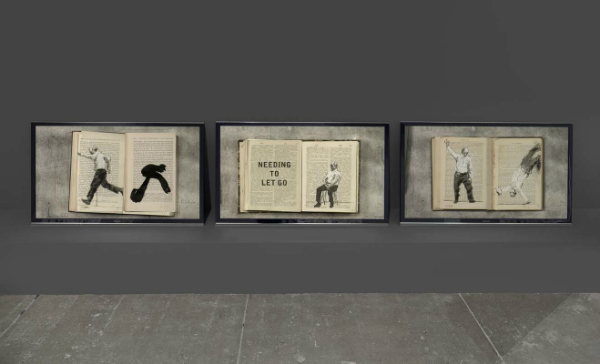
Triptych of flipbook films: Workshop Receipts, The Anatomy of Melancholy and Practical Enquiries (2012); copyright William Kentridge; Photo courtesy Annandale Galleries
It is easy to forget the enormity of the production of Kentridge’s work, because his animations are so easy to watch. Case in point is this trilogy: an object or figure seemingly leaps from page to page as they turn – at times Kentridge’s own image takes a stroll or walks over a chair. Text and typeface remain pivotal to the work; fields of colour and primary geometric forms help create pace and punctuation.
As Gregory said, ‘He gives us plenty of room to manoeuvre inside his works.’
Kentrigde is undeniably one of the most influential artists of our times and this exhibition does not disappoint. I sat for a good hour discussing the exhibition with a friend after seeing it, drawn to different aspects of the show but equally the works left an indelible impression.
Rating: 5+ out of 5
William Kentridge: So
Annandale Galleries
Until 24 May 5, 2014
www.annandalegalleries.com.au
